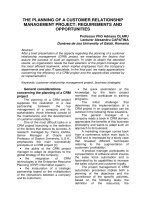Customer relationship management concepts and technologies, second edition francis buttle
Bạn đang xem bản rút gọn của tài liệu. Xem và tải ngay bản đầy đủ của tài liệu tại đây (7.55 MB, 523 trang )
Customer Relationship Management
VSF
This book is dedicated to my children Emma and Lewis of whom I am
enormously proud.
Customer
Relationship
Management
Concepts and Technologies
Second edition
Francis Buttle
AMSTERDAM • BOSTON • HEIDELBERG • LONDON • NEW YORK • OXFORD
PARIS • SAN DIEGO • SAN FRANCISCO • SINGAPORE • SYDNEY • TOKYO
Butterworth-Heinemann is an imprint of Elsevier
Butterworth-Heinemann is an imprint of Elsevier
Linacre House, Jordan Hill, Oxford OX2 8DP
30 Corporate Drive, Suite 400, Burlington, MA 01803, USA
First edition 2009
Copyright © 2009, Francis Buttle
Published by Elsevier Ltd. All rights reserved.
The right of Francis Buttle to be identified as the author of this work has been
asserted in accordance with the Copyright, Designs and Patents Act 1988
No part of this publication may be reproduced, stored in a retrieval system, or
transmitted in any form or by any means electronic, mechanical, photocopying,
recording or otherwise without the prior written permission of the publisher.
Permissions may be sought directly from Elsevier’s Science & Technology Rights
Department in Oxford, UK: phone (ϩ44) (0) 1865 843830; fax: (ϩ44) (0) 1865
853333; email: Alternatively you can submit your
request online by visiting the Elsevier web site at />permissions, and selecting Obtaining permission to use Elsevier material.
Notice
No responsibility is assumed by the publisher for any injury and/or damage to
persons or property as a matter of products liability, negligence or otherwise,
or from any use or operation of any methods, products, instructions or ideas
contained in the material herein. Because of rapid advances in the medical
sciences, in particular, independent verification of diagnoses and drug dosages
should be made.
British Library Cataloguing-in-Publication Data
A catalogue record for this book is available from the British Library
Library of Congress Cataloging-in-Publication Data
A catalog record for this book is available from the Library of Congress
ISBN: 978-1-85617-522-7
For information on all Butterworth-Heinemann publications
visit our web site at www.elsevierdirect.com
Typeset by Charon Tec Ltd., A Macmillan Company.
(www.macmillansolutions.com).
Printed and bound in Hungary
09 10 11 12 13
10 9 8 7 6 5 4 3 2 1
Contents
Foreword
Preface
Acknowledgements
About the author
xi
xiii
xvii
xxi
1 Introduction to customer relationship management
Chapter objectives
Introduction
Strategic CRM
Operational CRM
Analytical CRM
Collaborative CRM
Misunderstandings about CRM
Defining CRM
CRM constituencies
Commercial contexts of CRM
The not-for-profit context
Models of CRM
Summary
References
1
3
3
4
6
9
11
12
14
16
17
18
18
22
22
2 Understanding relationships
Chapter objectives
What is a relationship?
Relationship quality
Why companies want relationships with customers
Why companies do NOT want relationships with customers
Why customers want relationships with suppliers
Why customers do NOT want relationships with suppliers
Customer satisfaction, loyalty and business performance
Researching the satisfaction–profit chain
Relationship management theories
Summary
References
25
27
27
30
31
40
41
42
43
46
50
55
55
3 Planning and implementing customer relationship
management projects
Chapter objectives
Introduction
61
63
63
vi Contents
CRM implementation
Phase 1: Develop the CRM strategy
Phase 2: Build CRM project foundations
Phase 3: Needs specification and partner selection
Phase 4: Project implementation
Phase 5: Evaluate performance
Summary
References
63
65
72
80
89
90
91
91
4 Developing, managing and using customer-related databases
Chapter objectives
Introduction
What is a customer-related database?
Developing a customer-related database
Select the database technology and hardware platform
Maintain the database
Desirable data attributes
Data integration
Data warehousing
Data marts
Data access and interrogation
Data mining
Privacy issues
Summary
References
93
95
95
95
96
102
107
108
109
111
112
113
114
117
120
120
5 Customer portfolio management
Chapter objectives
What is a portfolio?
Who is the customer?
Basic disciplines for CPM
Market segmentation
Sales forecasting
Activity-based costing
Lifetime value estimation
Data mining
CPM in the business-to-business context
Additional customer portfolio management tools
Strategically significant customers
The seven core customer management strategies
Summary
References
123
125
125
126
127
127
136
138
141
143
147
154
157
158
160
160
6 Customer relationship management and customer
experience
Chapter objectives
Introduction
What is meant by customer experience?
Experiential marketing strategies and tactics
Customer experience and the role of CRM
163
165
165
165
174
178
Contents vii
Features of CRM software applications that influence
customer experience
Researching the link between customer experience and CRM
Summary
References
179
182
183
183
7 Creating value for customers
Chapter objectives
Introduction
Understanding value
Sources of customer value
Customization
Value from products
Value from service
Value from processes
Value from people
Value from physical evidence
Value from customer communication
Value from channels
Summary
References
185
187
187
187
191
193
197
201
210
213
214
216
218
219
220
8 Managing the customer lifecycle: customer acquisition
Chapter objectives
Introduction
What is a new customer?
Customer value estimates
Prospecting
Key performance indicators of customer acquisition programmes
Making the right offer
Operational CRM tools that help customer acquisition
Support from CRM analytics
Summary
References
225
227
227
228
231
233
248
249
250
252
253
253
9 Managing the customer lifecycle: customer retention
and development
Chapter objectives
Introduction
What is customer retention?
Manage customer retention or value retention?
Economics of customer retention
Which customers to retain?
Strategies for customer retention
Positive customer retention strategies
Learning from research into customer commitment
Context makes a difference
Key performance indicators of customer retention programmes
The role of research
Strategies for customer development
255
257
257
258
260
261
262
263
263
277
280
281
282
283
viii Contents
Strategies for terminating customer relationships
Summary
References
284
287
287
10 Managing networks for customer relationship
management performance
Chapter objectives
Introduction
What is a network?
Business networks
Network position
What is meant by ‘focal firm?’
Business networks and CRM
The SCOPE of CRM
Supplier networks
Distribution networks
Principles of network management
Management of networks
Management in networks
Research into network competence
Summary
References
291
293
293
294
295
296
298
298
299
300
301
303
303
306
307
307
308
11 Managing supplier and partner relationships
Chapter objectives
Introduction
Supplier relationships
Product development
Supplier accreditation programmes
Process alignment
Trends in supplier relationship management
Product development alliances
Electronic procurement
Partners
Partners in value creation
Alliances between non-competing firms
Alliances between competing firms
Category teams
Benchmarking partners
Regulators
Customer advocacy groups
Sponsors
Partners in value delivery
Summary
References
311
313
313
314
315
315
317
320
323
324
327
327
329
330
331
331
333
333
335
336
340
340
12 Managing investor and employee relationships
Chapter objectives
Introduction
Owner/investor relationships
343
345
345
345
Contents ix
Educate current investors
Investor relations portals
Employees
Internal marketing
Empowerment
The service–profit chain
Employee relationship management (ERM) software
applications
Summary
References
349
351
351
353
354
355
357
359
360
13 Information technology for customer relationship
management
Chapter objectives
Introduction
Origins of CRM technology
The CRM ecosystem
CRM solutions
CRM analytics
CRM architecture
Multichannel CRM
Mobile and wireless solutions
Integration
Knowledge management
Automated workflow
Summary
References
363
365
365
365
369
372
377
381
381
383
385
389
390
391
392
14 Sales-force automation
Chapter objectives
Introduction
What is SFA?
The SFA ecosystem
SFA software functionality
SFA adoption
How SFA changes sales performance
Summary
References
393
395
395
396
396
398
406
408
409
410
15 Marketing automation
Chapter objectives
Introduction
What is marketing automation?
Benefits of marketing automation
Software applications for marketing
Summary
References
413
415
415
415
416
417
439
440
16 Service automation
Chapter objectives
Introduction
443
445
445
x Contents
What is customer service?
What is service automation?
Benefits from service automation
Software applications for service
Summary
References
445
447
449
450
461
461
17 Organizational issues and customer relationship
management
Chapter objectives
Introduction
Organizational roles and CRM
Strategic goals of CRM
Conventional customer management structures
Network and virtual organizations
Person-to-person contacts
Key account management
Team selling
Summary
References
463
465
465
465
469
469
474
475
476
481
482
483
Index
485
Foreword
Customer relationship management’s impact in the commercial
marketplace cannot be undervalued. Despite traditional economic theory
on market entry and pricing prescribing that enterprises should engage
customers through prefabricated reactions and interactions given the
customer event taking place, the nature, impact and reach of the power
of enriching customer experiences has emerged in 2008.
Yet, one of the most common mistakes made by global companies is to
view CRM as solely a technology or business challenge. CRM is first and
foremost a business strategy that can be effectively executed through the
appropriate business process and technology management capabilities
that best match to an organization’s customer-facing goals.
Long gone are the views of CRM being applications or business
process methodologies for engaging customers in contact centers in the
customer service functional domains within an organization. Today,
every interaction or ‘moment of truth’ with customers can help sustain,
direct, implore or resuscitate desired outcomes by enterprises. These
processes transcend functional departmental silos and extend their reach
across the process network to include sales and distribution partners and
channels. Technology, process and organizational architectures together
in concert will determine the effectiveness of how these end-to-end
business processes will align to customer intents and enrich their overall
experience with an organization.
The CRM strategic paradigm has gone through a three-phase
generational shift over the last decade (1998–2008) with enterprises
maturing from: 1) Marketing to customers the best products at the best
prices, to 2) Marketing customers with the best services, to 3) Marketing
customers with the dynamic services and products that they want and
desire as measured by customer intent. Today, with the advent and
proliferation of social communities across the internet world customers
have channels for information-sharing on an enterprise’s services and
products that is extremely powerful. This emergence has disrupted
conventional approaches towards managing customer or product
information. Paradoxically, customers no longer look towards an enterprise
as the best source of data or information about their own commercial
product or service offerings. This sense of brand promise and brand trust
has deteriorated, and today customers place their confidence in the shared
and communal experiences of others through social community networks
which provide transparency on valued customer experiences in the
marketplace. In fact, as this book is being printed a great number of CRM
Application vendors in the marketplace are vying to provide technology
solutions for enterprises to integrate and use these social networks as part
of core enterprise ERP and CRM solutions.
xii Foreword
It is with distinct pleasure that I introduce you to Francis Buttle’s
comprehensive work on CRM. His passion for and grasp of the concepts,
disruptors and application of CRM approaches will accelerate readers’
abilities to grasp these exciting topics.
When considering CRM, there is no strategic alternative for enterprises
but a relentless approach towards driving customer centricity in order to
achieve current, future and lifetime profitability by creating customers
for life.
Isher Kaila
Research Director, Global CRM Stratety
Gartner Inc.
San Jose, CA
USA
Preface
Welcome to the second edition of Customer Relationship Management:
Concepts and Technologies.
The book provides a comprehensive and balanced review of Customer
Relationship Management. It explains what CRM is, the benefits it
delivers, the contexts in which it is used, the technologies that are
deployed, and how it can be implemented. It shows how CRM practices
and technologies are used to enhance the achievement of marketing,
sales and service objectives throughout the customer life-cycle stages of
customer acquisition, retention and development, whilst simultaneously
supporting broader organizational goals.
The book has been written to meet the demand for an impartial,
academically-sound, examination of CRM. It is a learning resource both
for students of CRM and for managers wanting a better appreciation of
the role that CRM can play in their own organizations.
The first edition was entitled Customer Relationship Management:
Concepts and Tools. The change to the new subtitle, Concepts and
Technologies, reflects the requirements of readers. In true customeroriented manner, we surveyed readers and adopters of the first edition.
They said they wanted more on CRM technologies. This book delivers
it. However, although there are a number of chapters dedicated to CRM
technologies, and technology matters are considered throughout the book,
the book puts technology into a managerial context. This is not a book
about technologies, but it is about how marketers, salespeople, service
staff and their managers can use technologies to better understand and
meet the requirements of customers, whilst also meeting organizational
goals and objectives. Our survey of readers and adopters also discovered
that they wanted more case illustrations and screenshots from CRM
software applications. The book delivers them, too.
The book draws on academic and independent research to ensure
that it is both theoretically sound and managerially relevant. Research
from a wide range of academic disciplines contributes to the book.
These include marketing, sales, customer service, human resources,
xiv Preface
technology management, strategy, change management, project
management, leadership, operations, management accounting, finance
and organizational behaviour. Supplementing these academic credentials,
the book also makes use of research conducted by independent analysts
such as Gartner and Forrester, two organizations that conduct leadingedge, state-of-the-art research into CRM and related areas.
Audience for the book
This book has been written for a number of audiences, all of whom share
an interest in improving their understanding of CRM.
●
●
●
●
●
MBA and Masters students, and upper-level undergraduates studying
CRM or related advanced courses, such as relationship marketing,
database marketing, customer management, sales management,
key account management, strategic management, customer value
management and customer service management.
Those pursuing professional qualifications or accreditation in
marketing through international organizations, such as the Chartered
Institute of Marketing and the Institute of Direct Marketing, or national
bodies such as the Marketing Institute of Ireland or the Canadian
Institute of Marketing.
Senior and mid-level managers who are involved in CRM programmes
and system implementations, whether in a marketing department, the
sales-force or the service centre.
Students pursuing professional qualifications or accreditation in sales
management or key account management through international
organizations such as the Institute of Sales and Marketing Management
or the Association of International Marketing.
CRM users who want a better understanding of this complex area. CRM
tools are deployed across the customer-facing parts of organizations.
Users includes sales representatives, account managers, marketing
managers, market analysts, campaign managers, market managers,
customer relationship managers and customer service managers. These
users are exposed to just a fragment of the CRM universe. This book
can put their role into broader context.
Key features of the book
●
●
The book provides a helicopter view, an overview, of the domain of
CRM. As an impartial review of the field, it is not tied to any particular
perspective on CRM. Indeed, the book identifies a number of holistic
models that provide different and competing overviews of CRM.
Although CRM is in widespread use, there is still some misunderstanding about what CRM is. The book identifies four different
types of CRM: strategic, operational, analytical and collaborative.
Preface xv
●
●
●
●
●
●
Several chapters are dedicated to strategic CRM and others focus on
operational CRM, whereas analytical CRM and collaborative CRM
issues are addressed throughout the book.
The book defines CRM as the core business strategy that integrates
internal processes and functions, and external networks, to create
and deliver value to targeted customers at a profit. CRM is grounded
on high quality customer-related data and enabled by information
technology. This definition serves as a central point-of-reference
throughout the book.
The book emphasizes a managerial perspective on CRM. Although
there is plenty of content on technology, it is not a book about
technology per se. The technology content of the book has been
written so that readers who are unfamiliar with technology, or who
are technophobes, can still understand what CRM technologies can
deliver. Technology is secondary to management throughout the
book. You don’t need a degree in information systems to benefit from
the book!
The book has a strong academic foundation provided by research
from a number of disciplines.
The book contains many examples of CRM technologies and their
application to marketing, selling or service functions. Screenshots are
a feature of the book.
Every chapter contains case illustrations. These are not problem-based
cases, but examples of CRM in practice so that readers can come to
appreciate how CRM is deployed.
All chapters follow a common format: learning objectives, text, case
illustrations, summary and references.
Improvements over the
first edition
There are a number of important improvements to this edition which
have been made largely as a result of input from readers and adopters.
The book is significantly expanded. At seventeen chapters, this
edition is seven chapters longer than the first edition. There are three
new chapters dedicated to operational CRM applications: sales-force
automation, marketing automation and service automation. The chapters
define important terms, identify the main vendors and actors, and set
out the benefits users can expect to experience and the functionality
that is available. There is a new chapter entitled ‘Understanding
relationships’. If CRM is about developing and maintaining relationships
with customers, it is important to have clear understanding of what
a relationship looks like, and how, if at all, it can be managed. This
chapter defines the term ‘relationship’, examines whether customers
want relationships with suppliers and vice versa, identifies attributes of
successful relationships and reviews five different schools of thought
that have influenced relationship management in a business context.
xvi Preface
There is a new chapter on planning and implementing CRM projects.
This takes readers through a disciplined five-stage process designed to
promote successful CRM outcomes. There is a new chapter on ‘Customer
experience’. Customer experience has become something of a buzzword
in the last few years. This chapter explores the concept of customer
experience, and addresses the question of whether CRM can or does
enhance customer experience.
Many new case illustrations have been added to every chapter, and
all other content has been revised and updated. An added feature of
this edition is the inclusion of a large number screenshots from CRM
software applications. This is designed to give readers a sense of the
CRM user’s experience.
A final enhancement to this edition is the provision of an array of
enriching online content, which is described below.
Additional online resources
Readers and adopters of the first edition said they wanted additional
online resources to be available. There are now two websites linked to
the book, designed to enrich the learning experience.
The website for adopters provides a range of pedagogical resources
for instructors. Accessed by password and only available to authorized
instructors, the site contains a full set of PowerPoint files; details of case
studies that can be used as a basis for classroom discussion or student
assignments; links to technology companies’ websites where CRM
technologies are demonstrated, and white papers and case histories
can be viewed; links on online CRM communities and links to analysts
websites where up-to-date CRM-related research is published. The
adopters’ website also includes a list of discussion topics, exercises,
projects and assignments that engage students and promote deeper,
more meaningful, learning.
The website for readers provides access to a range of value-adding
content including chapter-by-chapter learning objectives; links
to technology companies’ websites where CRM technologies are
demonstrated, and white papers and case histories can be viewed; links
to online CRM communities; and links to analysts websites where up-todate CRM-related research is published.
I hope you enjoy the book and find it a satisfying read. Writing a book
is a little like painting a picture, or tending a garden. You never reach a
point where you can safely say that the job is finished. There is always
more that you can do. With that in mind, I invite you to write to me at
I look forward to hearing from you.
Francis Buttle
Sydney
Acknowledgements
I’d like to express my appreciation to the many people and organizations
that have contributed to this book. Most of these contributions have
been requested and conscientiously delivered, but other contributors are
unaware that their occasional comment or question is reflected in these
pages. I thank you all.
I would particularly like to acknowledge the contribution of Isher Kaila
who wrote the book’s Foreword. Isher is Research Director, Global CRM
Strategy for Gartner Inc., San Jose, California, USA. Gartner is the world’s
leading information technology research and advisory company. I first met
Isher on one of his many global tours. He was visiting Australia where
I had the opportunity to hear him speak insightfully and informatively
about trends in CRM and customer experience management. Gartner
claims ‘We deliver the technology-related insight necessary for our clients
to make the right decisions, every day’. Isher certainly did on that day,
and he makes some similarly shrewd observations in his Foreword.
I would also like to acknowledge the input of John Turnbull and
Matthew Holden. I have a strong managerial and strategic emphasis on
CRM, which privileges the perspective of the user. In my 15 years or so
of teaching, researching, advising and consulting on CRM I have learned
much about technology, but am I by no means a match for these two
technology experts.
John Turnbull is the founder and Managing Director of Customer
Connect Australia (www.customerconnect.com.au). John began his
working life with operational and management roles in service, sales,
marketing support and project management. He has managed business
transition programmes for a wide range of organizations across
marketing, sales, service and operations. His experience also includes
managing the sales consulting organizations in Australia and New
Zealand for two major CRM vendors, PeopleSoft and Siebel (now Oracle).
At Customer Connect Australia, John has helped organizations in a wide
range of industries to succeed with their customer-centricity/customer
management programmes. His work includes business consulting, CRM
xviii Acknowledgements
strategy, customer management education, managing business transition
and customer management (CMAT™) assessment. John contributed a
chapter to the first edition of this book, and the current Chapter 13, IT for
CRM, draws heavily on that foundation. John and I have worked together
on a number of CRM educational projects.
Matthew Holden is a highly experienced IT executive who has held
senior positions at both Oracle and SAP. Currently based in Singapore,
he has been a lead CRM implementation consultant at various companies
including Fosters Ltd, AAPT and Cellarmaster Wines. He now works
with large Asian companies and governments across the entire
information technology software spectrum from ERP to CRM. More
information is available at www.matthewholden.com.au. I first met
Matthew when he enrolled as a PhD candidate and I had the pleasure of
assisting him on the doctoral pathway. We have since worked together on
a number of CRM educational projects. John and Matthew both read and
commented on the technology-heavy chapters of this book. Thank you
both for your input.
A number of doctoral candidates that I have supervised or advised
have contributed significantly to the book. Special mention must go to
Daniel Prior who identified and reviewed a number of different schools
of relationship management. His thoughtful analysis provides a strong
foundation for the discussion in Chapter 2. A number of chapters
were read and critiqued by doctoral candidates Sergio Biggemann,
Martin Williams, Reiny Iriana and Chris Baumann. Thank you, and
congratulations on your own achievements: you are all Doctors now.
May you continue to be successful. Jana Bowden also reviewed early
drafts of chapters. You’re the next to graduate.
A number of academic colleagues past, present and perhaps future,
have also contributed feedback on drafts or engaged in helpful debate
and discussion, amongst them Lawrence Ang, David Ballantyne, Sue
Creswick, Christine Ennew, Robert East, John Murphy, Pete Naude,
Sharon Murray, Adrian Payne, Thomas Ritter, Willem Selen, Alan
Thomas, Ian Wilkinson, Steve Worthington and Louise Young.
I’d like to thank a number of clients with whom I’ve worked,
including DNAML, MGSM, Microsoft, NIB, Nu-Wa, SAS and PLAUT.
Special mention goes to Adam Schmidt, Bill Gates, Asha Oudit, Bob
Knox, Helene Cederqvist and David Prior.
Many publishers, companies and authors have granted permission for
their copyright materials to be reproduced in this book. These include
photographs, line drawings, conceptual models, research data and
screenshots. Every effort has been made to identify and contact copyright
owners, and I am very pleased to acknowledge their contributions in
the body of the book and in chapter endnotes. In the event that there
has been any failure to acknowledge a source appropriately, please let
me know and I’ll correct the omission or amend the error at the first
opportunity.
To all those at Elsevier who have been involved in the process of
bringing the book to market I extend a vote of thanks: Ailsa Marks, Tim
Goodfellow, Liz Burton, Sarah You and Stephani Allison. Appreciation is
also extended to Lewis Buttle of eLAB Design who designed the cover.
Acknowledgements xix
Thanks, too, to my colleagues at Francis Buttle & Associates (www.
buttleassociates.com) including Sam English, Lawrence Ang, Lee
Williams, Abdullah Aldlaigan and Rizal Ahmad. Also, I appreciate the
support of colleagues at Listening Post (www.listeningpost.com.au),
particularly Leigh Thomas, David Young and Andrew Jones.
Finally, if you want to get in touch about the book, you can reach me
at
This page intentionally left blank
About the author
Francis Buttle, PhD, is founder and principal consultant of Francis Buttle &
Associates, a Sydney, Australia-based business that helps organizations
become more skilled and successful at customer acquisition, retention
and development. Francis has spent most of the last 30 years in various
academic roles around the world. He has been a Professor of Customer
Relationship Management, Professor of Marketing, Professor of Relationship Marketing and Professor of Management at a number of leading
graduate schools of management, including Manchester Business School
(UK), Cranfield School of Management (UK) and Macquarie Graduate
School of Management (Australia). He was appointed as the world’s first
Professor of CRM in 1995, and remains an Adjunct Professor at MGSM.
Francis has authored, co-authored or edited seven books, and over
100 peer-reviewed academic journal articles or conference papers.
In addition, he is a frequent contributor to practitioner magazines,
presenter at business conferences and a serial blogger.
Francis has developed, run or contributed to many management
development programs, and has advised or consulted to numerous forprofit and not-for-profit organizations in the UK, Australia, USA, Hong
Kong, Singapore and New Zealand.
Although he quit full-time academic life in 2006, he still supervises
doctoral candidates and conducts customer-related research. Francis
lives on Sydney’s North Shore, is a qualified but reluctantly retired
rugby union referee, enjoys cycling and kayaking, and rides a Suzuki.
Francis has degrees in management science, marketing and
communication. His PhD was earned at the University of Massachusetts.
He is an elected Fellow of the Chartered Institute of Marketing. He can
be contacted at
This page intentionally left blank
Chapter 1
Introduction to
customer relationship
management
This page intentionally left blank









